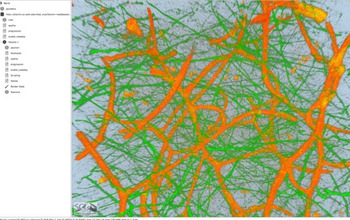All Images
News Release 15-134
Speeding up extreme big brain data analysis
Interactive software tool lets brain researchers explore large-scale, high-res imaging to better understand connections in the brain
This material is available primarily for archival purposes. Telephone numbers or other contact information may be out of date; please see current contact information at media contacts.

An NSF-funded team has developed a tool that allows brain researchers to better visualize the complex connections between neurons.
Shown here is a zoomed in region of the visual cortex in a macaque brain. The tool allows neuroscientists to more easily navigate blood vessels (orange) and neurons (green).
Credit: Cameron Christensen, University of Utah
Download the high-resolution PNG version of the image. (4.5 MB)
Use your mouse to right-click (Mac users may need to Ctrl-click) the link above and choose the option that will save the file or target to your computer.

Angelucci and her colleagues used the technology to stream 3-D images of a primate's visual cortex.
They paired this tool with a neuroscience technique called CLARITY, which makes surrounding brain tissue transparent. Shown here is a brain becoming transparent, thanks to CLARITY.
Credit: Frederick Federer, University of Utah
Download the high-resolution JPG version of the image. (190.3 KB)
Use your mouse to right-click (Mac users may need to Ctrl-click) the link above and choose the option that will save the file or target to your computer.

The technology known as ViSUS has been used for years in several different areas of research, including clean energy simulations on high performance computing platforms.
The software processes interactively terascale-sized datasets. The typical laptop has about 4-to-15 gigabytes of memory. One terabyte has 1,000 times that much. A whole mouse brain is about 31 terabytes of imaging data. That is the same amount of data as about 32 billion digital photographs.
The visual cortex of the macaque brain, which Angelucci studies, is 318 terabytes -- 100 times more.
Credit: Frederick Federer, University of Utah
Download the high-resolution PNG version of the image. (191.0 KB)
Use your mouse to right-click (Mac users may need to Ctrl-click) the link above and choose the option that will save the file or target to your computer.

There is great need for more efficient data-processing approaches as microscopes, telescopes and other instruments improve to acquire larger amounts of high-quality data.
Big data tools are vital to advance understanding of the brain, universe and other topics, as evidenced by national efforts such as the BRAIN Initiative.
Shown here is a portion of the macaque visual cortex shown using the ViSUS Powerwall viewer.
Credit: Vincent Horiuchi, University of Utah
Download the high-resolution JPG version of the image. (2.2 MB)
Use your mouse to right-click (Mac users may need to Ctrl-click) the link above and choose the option that will save the file or target to your computer.

Data can be explored interactively using a variety of visualization methods. Shown here is high-resolution image of a macaque visual cortex. The neurons are in a 2.5 millimeter-squared region.
Credit: Cameron Christensen, University of Utah
Download the high-resolution PNG version of the image. (64.5 MB)
Use your mouse to right-click (Mac users may need to Ctrl-click) the link above and choose the option that will save the file or target to your computer.


